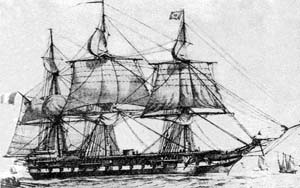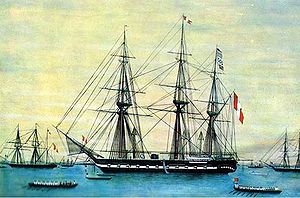Peruvian frigate Apurímac
 The frigate Apurimac on sails
| |
| History | |
|---|---|
| Name | Apurímac |
| Ordered | August, 1852 |
| Builder | Richard & Harvey Green Shipyard, Blackwall (United Kingdom) |
| Laid down | 1853 |
| Launched | July, 1854 |
| Commissioned | August, 1855 |
| Renamed | Callao (1858-1863) |
| Fate | Scuttled to prevent capture in the Callao harbor, January 161881 |
| Notes | Serve as training ship from 1873 |
| General characteristics | |
| Class and type | screw-propelled steam frigate |
| Tons burthen | 1666 tons B.O.M. (British Old Measurement) |
| Length | 62.17 m (204.0 ft) |
| Beam | 13.10 m (43.0 ft) |
| Draft | 7.16 m (23.5 ft) |
| Propulsion | list error: <br /> list (help) 300 hp (220 kW) alternative steam engine made by James Watt & Co 1-shaft with a folding helix |
| Sail plan | Frigate sail rigging |
| Speed | list error: <br /> list (help) 9 kn (17 km/h) on steam 14 kn (26 km/h) on sail |
| Complement | 200 crewman |
| Armament | list error: <br /> list (help) 12 32-pounder smoothbore guns 8 68-pounder smoothbore guns |
The Apurimac was the second steam frigate of the Peruvian Navy, built in England in 1855 along with the steamers Loa and Tumbes as a part of a major built-up of the Navy during the government of President José Rufino Echenique. Veteran of two wars and many internal conflicts, from 1873 due to its age it served as training ship in the Callao port until January 17,1881, when she was scuttled along with the rest of the Peruvian Navy to prevent capture by the Chilean troops who occupied the port after the defeat of the Peruvian Army in the battle of San Juan.
Construction
In 1852, Peru had one of the most powerful navies in the continent. It counted with two steam warships: The paddle steamer Rímac and the screw frigate Amazonas, and was surpassed only by Brazil and the United States of America, but inferior to the fleets that France and England had in the Pacific, which were also recently reinforced with steam warships. In order to prevent an European intervention (The Royal Navy had several encounters with the Peruvian Navy in 1830 and 1844), a commission was sent to England to order three more steam warships: A screw frigate and two schooners. Therefore, the Apurímac was ordered in August, 1852 and build in the Richard & Harvey Green Shipyard, London; under the supervision of the Chilean Captain Jose Maria Salcedo, who served in the Peruvian Navy. The ship was commissioned in August, 1855 and arrive to the port of Callao in November 12, 1855.
Peruvian Civil War of 1856-58
In November 16, 1856 the frigate, anchored in Arica, was taken by two young officers in favor of Manuel Ignacio de Vivanco, these were the Second Lieutenant Lizardo Montero and the Lieutenant Miguel Grau, who take the opportunity to seize the ship when its commander, Captain José María Salcedo; was in land visiting the house of the local British Consul. The first act of the rebel ship was the release of the political prisoners taken by the President Ramon Castilla in the hulks Caupolicán and Highlander in Arica.
Then, the Apurímac sails north and stirs up an insurrection on the schooner Loa, send by the government to intercept the rebel ship. By this point the President Castilla declare than the rebel ships are pirate ships and set a reward of 200 thousand pesos for its capture and devolution. Therefore, the government send a fleet composited by the steamers Tumbes and Izcuchaca, under the command of the Captain Ignacio Mariátegui to capture the rebels ships, but in November 17 the Tumbes defected in favor of the rebels, leaving the government only with the steamer Ucayali as the sole significant warship of the Peruvian Navy (the steam frigate Amazonas was in course to Hong Kong for repairs).

In November 27, the Apurímac and Tumbes raid and leave the port of Arica after the refuse of the garrison to resupply the rebel ships. Few days later, in December 28, the fleet capture the Chincha Islands and the steamer Izcuchaca. By the end of the year, the original reward for her capture was raised to 500 thousand pesos.
A few days later, the Apurimac along with the schooners Loa y Tumbes, began the blockade of Callao port in December 31, which was defended only by the Ucayali and the old colonial fortress of Real Felipe, after January 4 the blockade was sustained only by the frigate which try to capture the Ucayali in January 28, but the ship was well defended by the commander Mariátegui and the guns in land. Finally, the frigate leave the port by March 30 to resupply in Pisco.
The ship return in April 30, carrying Vivanco and his army on board with the help of the steamer Huaras, disembarking all the troops the next day in the mouth of the Rimac river with the intention of capture the port by surprise, but the assault was a complete failure and Vivanco with his remaining troops leave the Callao in April 26 to meet the rest of the rebel fleet in the Chincha Islands.
But the Peruvian government take new measures to recover the control of the sea, and in May 21 sign an accord with the representatives of Great Britain and France to allow their ships to protect the guano production and their economical interests, at the same time the president Castilla offers the unconditional pardon to the rebellious sailors. Knowing this, along with the fact than the Apurimac can be defeated by the French and British steam frigates, the rebel officers decide surrender the fleet, which leave the Chincha islands in May 22, and enter to be seized by the government in the Callao harbor two days later.
War with Ecuador of 1857-60
Renamed Callao by the president Castilla in April 28, 1858, the frigate participated in the blockade of Guayaquil under the command of the Admiral Ignacio Mariátegui as flagship of the Peruvian Navy, the blockade start in November 4, 1858; and last for a year until the disembark and capture of the port in the month of November, 1860.
After the campaign, the frigate was laid up in a floating dock near the San Lorenzo island, but in December 17, 1860 the ship sank along with the dock. On board the ship was its commander, Captain Silva Rodríguez and the entire crew, including cookers, musicians and visitors from the Callao harbor. The ship felt to starboard, killing 100 persons, including crewman and dock operators, and leave 88 wounded.
Rising and reconstruction
In order to recover the ship the Plenipotentiary Minister of Perú in the United States, Federico Barreda, contracted the brothers Renton and Addison Crosby in Brooklyn for 100 thousand pesos to perform the difficult task. The ship was almost raised in September 11, 1863; but the lack of hoses to extract the water of the hull prevent it, and sunk again. The ship was finally raised and beached in the San Lorenzo island in April 16, 1863 and renamed again Apurimac.
After 3 years submerged, the ship receive extensive repairs and reconstruction between 1863 and 1864, which include the addition of rail armor in the floating line and the hull was protected with chains; but this modifications reduce the speed of the frigate to 7 knots with steam, and affect her maneuverability. The start of the the Civil War of 1865 caught the Apurímac without masting, nevertheless the frigate participated in the bombardment of Arica that same year.
The Chincha Islands War and the Naval Battle of Abtao
Immediately after the declaration of war against Spain, the Apurimac (still unmasted) along with the steam frigate Amazonas were send to Chile under the command of the Captain Lizardo Montero to join the Chilean schooner Covadonga in the Chiloé Archipelago, in order to wait the arrival of two new steam corvettes of the Peruvian Navy, the Unión and America. In the voyage the Amazonas was lost near Punta Quilque, and the Apurímac suffered from engine problems, but the fleet finally reunite in February 4, 1866 in the recently established Chayalhue naval post, in the island of Abtao; under the command of the Peruvian Captain Manuel Villar.
In February 7, the Spanish steam frigates Reina Blanca and Villa de Madrid appeared off the inlet of Abtao, the allied fleet, aware of the enemy presence form a line of battle in the opposite inlet, covering the three entrances to the naval post. The Spanish frigates slowly enter into the cove but the Apurimac start the battle opening fire at 1500 meters, being followed by the rest of the allied fleet.
The Spanish ships return the fire with anger, but the accurate shots of the allied ships forced them to seek cover behind the Abtao island and continued the battle with elevation shots; they slowly retreat after two hours of battle and 1500 shots from both sides. The Apurimac receive moderated damage, with three impacts in her floating line and minor damage on the deck. The ship remain in Chile until the end of the war.
Later years: War of the Pacific
After her arrival to the Callao, the ship receive general repairs and was finally masted, serving until 1873 when her boilers become unusable and were removed, then the frigate was recommissioned as a training vessel. In 1877, the rail and chain armor installed in 1865 was removed during a major repair, allowing her to recover its original stability.
The frigate continued serving in that role until the start of the War of the Pacific, when the Apurimac remain in the Callao harbor as a hulk during the first part of the war. Later, she survive unharmed from the continuous attacks of the Chilean Navy during the blockade of Callao between 1880 and 1881, but after the defeat of the Peruvian Army in the battles of San Juan and Miraflores, the Secretary of the Navy, Captain Manuel Villar, ordered in the night of January 16, 1881 the destruction of the port defenses and the remaining ships of the Peruvian Navy, including the frigate Apurimac, to prevent the capture by the Chilean troops. The order was executed by the captains Germán Astete and Manuel Villavisencio during the dawn of January 17, 1881.
See also
Sources
- Template:Sp icon Grau Seminario, Miguel, Memoria de Marina. 1878.
- Template:Sp icon Carvajal Pareja, Melitón, Historia Marítima del Perú, Tomo XI, volumen 2, Lima. Instituto de Estudios Histórico Marítimos del Perú. ISBN 9972-633-05-5. 2006.
- Template:Sp icon Yábar Acuña, Francisco, Las Fuerzas Sútiles y la defensa de costa en la Guerra del Pacífico, Fondo de Publicaciones Dirección de Intereses Marítimos. 2001.
- Template:Sp icon "El Combate de Abtao – Los Partes de Guerra - 1". Cuadernos de Caicaen. Retrieved 2008-07-10.
- Template:Sp icon "Fragata Apurímac". Peruvian Navy Website. Retrieved 2008-07-10.
